|
THERE'S TREASURE EVERYWHERE
Gradius V (PAL PS2)
Available from www.play.com, £17.99 delivered
An email from a videogames programmer arrived at the glamorous metropolitan headquarters of World Of Stuart last week. Normally that signifies that it's time to secure all the locks and check that your reporter's hospital insurance premiums are up to date, but unusually, this was a nice email. It referred to a WoS feature on a game which was an updated remake of a classic, and contained, among other things, a perceptive insight. Talking about the temptation to ruin remakes and sequels by throwing in too many new features and upsetting the existing balance, the coder said of his own - excellent - sequel, "I'm glad most people notice the visual changes, and not the gameplay tweaks".
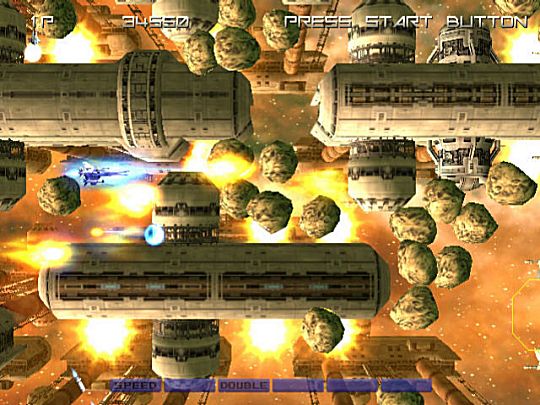
Enjoy this pic now, because you won't see the stage it comes from for a long time.
In the space year 2000, Konami made their debut on the then-fledgling PS2 with a game seemingly designed for the sole purpose of illustrating exactly how out-of-date their venerable Gradius series was going to look in the new dawn of videogaming heralded by the 128-bit generation of consoles. Gradius IV (bundled along with a straight port of the SNES/coin-op title Gradius III) had graphics which for the first few levels could have come from the original 1985 Gradius, and which made only a few token efforts at showcasing the new console's power after that. (Via some rather cheap distortion and rotation effects uncannily reminiscent of the "Mode 7" chip of the SNES.)
More importantly, though, it had gameplay that extended and amplified everything that was wrong with the basic Gradius design. Absurdly, unfairly hard, Gradius IV was a joyless trial in which your game was essentially over as soon as you lost a life anywhere beyond Stage One. The tiniest slip, or accidental nudge of your horribly twitchy craft against the scenery, and you'd be instantly dumped back half a level with no weapons and a ship so slow it struggled to intercept even the first wave of cannon-fodder enemies designed to at least furnish you with a basic speed-up. Even with the difficulty set to its easiest and nine ships for every credit, the game was so desperately unenjoyable that few players could be bothered going through the grim motions of slogging their way laboriously to the end.
What's most remarkable about Gradius V (actually about the 25th distinct game in the series), then, is this: at first, you don't really notice that anything's changed.
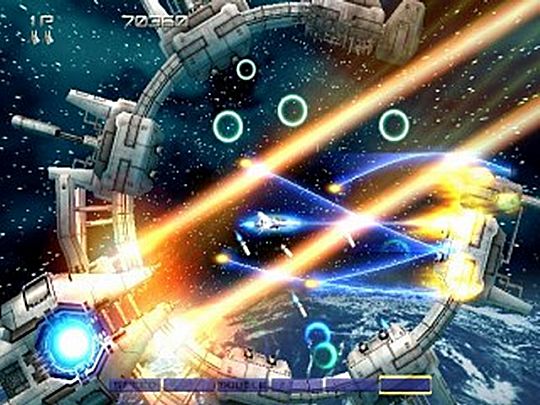
You'll feel like punching the air in joy too.
Like OutRun 2, Gradius V takes an old game and transforms it for the modern era, but in such a clever, sensitive and subtle way that its heritage remains instantly recognisable even as fundamental elements of the gameplay are changed or thrown away entirely. Coded by Treasure, the darlings of hardcore shmup fanboys the world over, it borrows both visually and design-wise from their earlier cult hits Ikaruga and Radiant Silvergun, but - while it's anything but a pushover - presents a much less daunting challenge than either of the bullet-hell legends. Nevertheless, the developer's mark is stamped all over this release from the company they originally split off from. As the title of this feature suggests, in Gradius V there's Treasure everywhere.
At the heart of everything that makes Gradius V wonderful is one simple but all-important change to the core gameplay. Previously, getting killed in a Gradius game cost you all your "Options", the invincible drone ships that were the original title's most pioneering feature. The game was so centred around the player's accumulation of Options that bereft of them, the player stood next to no chance against the fearsome onslaught of later levels, given that a full complement required the collection of at least 20 power-up tokens from vanquished enemies. And any distance at all into the middle or later stages of a Gradius game, your unenhanced ship would be lucky to survive long enough to pick up three.
In Gradius V, though, your death leaves your Options scattered around where they lay when your spacecraft exploded, from where they can be grabbed immediately by your new ship as it materialises, complete with a generous few seconds of complete invincibility. You still lose your speedups, your missiles and your lasers, but the crucial Options are there for the taking - and thanks to them, so are your enemies.
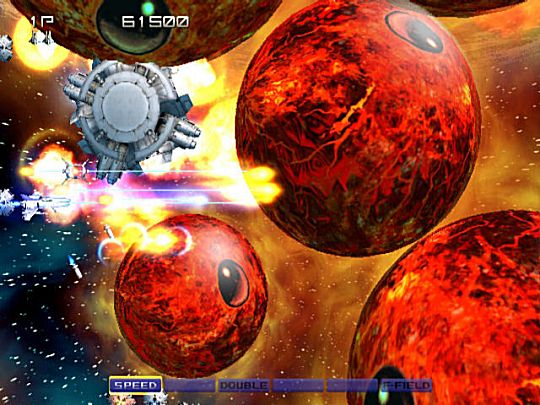
With even Stage Two pitting you against the likes of this, it's just as well Gradius V is fair.
The difference this single tweak makes to Gradius V is impossible to overstate. At a stroke it renders the game vastly more fair, yet without reducing the challenge. For make no mistake, this is a savagely hard game which will demand all the skill and concentration of even the most seasoned player. The first stage is a reasonably gentle introduction, but will still mercilessly punish the slightest drifting of your attention. The second is a brutally intense assault in a network of narrow corridors capped by a terrifying multiple-boss attack, frankly you probably don't even want to hear about the third and fourth stages just yet, and as for Stage Five... yipe. (And there are still three more to come after those, too.) Be afraid.
To give you a chance, your ship has some new abilities. Or rather, your Options do. As is traditional in most Gradius games, at the start you have a choice of "Weapon Array" - that is, exactly what power-ups your ship will be able to bolt on. The missiles, double shots, tailguns and forcefields are all familiar faces, but the biggest choice you face is in deciding which type of Options to enable. All perform the basic shadowing-your-ship function of the originals, but each of the types also has a secondary attribute, controlled with the R1 button.
Type 1 Options can fire in a different direction to the main ship, allowing you to shoot (say) behind and above your ship while it continues to fire straight ahead. The second type can be locked in position, allowing you to spread your fire across a wide range or concentrate it all into a single lethal line. Type 3s (the least useful, in this reviewer's experience) can be stretched out above and below your ship at various distances, and the fourth type spin around it in a close protective circle. Complicating the choice is the fact that Type 2 and Type 3 Options fire a standard fixed pulse laser, while Types 1 and 4 emit a continuous one, which bends as you move (see the pic below) and provides a more complete field of fire.
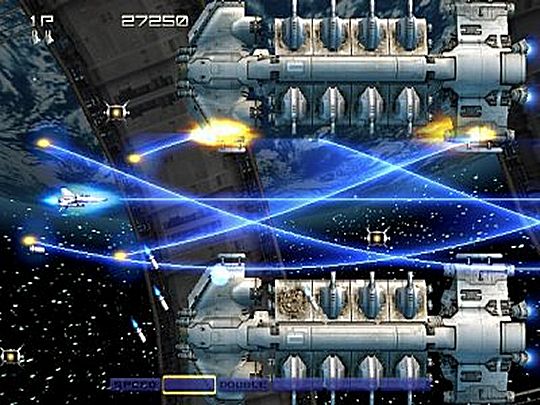
The bendy lasers (seen here in Type 4 incarnation) are excellent at carving out a path quickly.
These two changes are the only significant alterations to the core Gradius gameplay. The structure of Gradius V is otherwise identical to its predecessors, and from the first moments it feels like a Gradius game. The other way in which it distinguishes itself from them, though, is in the aesthetic execution. A casual observer looking at this game and Gradius IV would almost certainly arrive at the conclusion that the latter was running on an entirely different, altogether more primitive piece of hardware. In place of the plain black starfields of the earlier titles, Gradius V sets the action against spectacular, stunningly-rendered moving backdrops reminiscent of Ikaruga, and depicts the fighting in glorious, beautifully-lit semi-3D graphics. The cataclysmic destruction of the end-level bosses is truly a sight to behold. (Yet the whole thing is done with such respect for and attention to the distinctive Gradius style that even while you're appreciating the visual splendour, you don't fully grasp how much it's advanced until you go back and look at one of the earlier games.) And the bosses also mark an area in which V lifts itself above its prequels. In several of the previous games, and especially in IV, bosses were a trial-and-error memory test. Your ship would be swatted out of existence by attacks which were impossible to avoid unless you knew they were coming, and since your replacement ship was completely incapable of tackling the boss without its powerups, your chances of surviving long enough to see the next hazard in the sequence were slim. The only real choice was to start the entire game again, battle through to the boss, dodge the first attack, get killed by the next one and repeat.
Here, though, even the most deadly dangers come with some kind of prior warning, delivered in time to give you a fighting chance of responding to it. Even forewarned you're in for a difficult time, and each boss demands the careful construction of a strategy, but - in another parallel with OutRun 2, a game with which Gradius V unmistakeably shares a purity of spirit - when you lose, you never get the feeling you've been cheated.
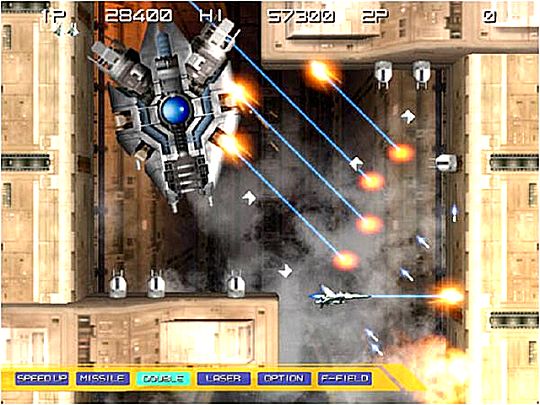
And here we can see a full complement of Type 1 Options covering your rear.
There are some areas where Gradius V outperforms the Sega title, though - most notably in its high-score table. For one thing, it does keep separate score tables for each of its seven difficulty settings. More impressive, though, it the way it actually handles high scores. In most multi-credit games (here you start off with just three credits, with more added the longer you play), using a continue robs you of your chance to enter your name on the high-score table, leading to the unfortunate situation whereby after a good start, you're faced with the choice of either carrying on, or throwing away the advantage to immortalise your score in lights. Gradius V, though, in a feature that's a new one to this veteran reporter and beautiful in its simplicity, simply remembers your first-credit score and, when you run out of credits or choose not to continue, goes back to it and lets you enter your name.
(This also operates as a welcome playing-field leveller for high scores. Some games make no distinction between scores gained from the beginning, and those which might have been started from a later point via a continue, and hence shouldn't really be compared.)
Such thoughtful consideration for the player is typical of Treasure, of course. Like all their games, Gradius V is designed to be, above all else, enjoyable. Compared to its cheap, sour-faced predecessor, which did its utmost to dismay and discourage the player from the opening minute onwards (Gradius IV started with a level so ugly and boring it's a wonder anyone progressed far enough to actually discover how awful the rest of it was), this game does everything in its power to make you want to keep playing, even after you've just been smeared all over the walls. Not only by virtue of the things described above (the recoverable Options, the high-score remembering), which directly encourage more play after a death or loss of a credit, but because it's just generally so lovely to play it.
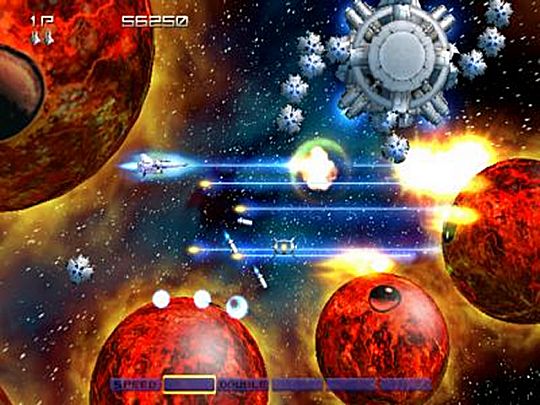
Yes, it IS pretty, isn't it?
As with all the best games, Gradius V's control is a model of simplicity, yet provides the player with a wealth of sophisticated abilities. (It's fully adjustable too, which one oughtn't need to mention in this day and age, but staggeringly there are developers out there too lazy, stupid or just plain shit to provide configurable controls. And often in games which need it far more than this one does, too.) All you need is the control pad (both the analogue stick and d-pad are supported), the fire button and the Option Configure button, and you can pilot your craft through all sorts of elegant and devastating manoeuvres.
Few things in gaming can ever have been more beautiful than taking a full complement of Type 1 Options with lasers activated and performing a 360-degree sweep, their neon glow leaving a pyrotechnic trail of flowering carnage in its wake. Very little in gaming has ever felt as powerful as concentrating all your Type 2 Option lasers from a towering four-line electric fence half the screen high into a single beam of pulsating death and wiping out a boss's core before it can unleash a lethal attack. And rarely can a player ever have felt as protected as by a force-field and a complete set of Type 4 Options equipped with double-shot, circling their ship like sentinels while pouring out a seemingly-impenetrable blizzard of bullets and missiles in all directions. (It's not impenetrable at all, of course, but that's where you come in.) No matter how you want to play, Gradius V makes the equipment available.
(Later, you can also unlock a "Weapon Edit" mode, where you can pick'n'mix from all the various weapon choices, pairing bendy-laser Rotate Options with two-way forward-firing missiles and a tailgun, or whatever you feel like.)
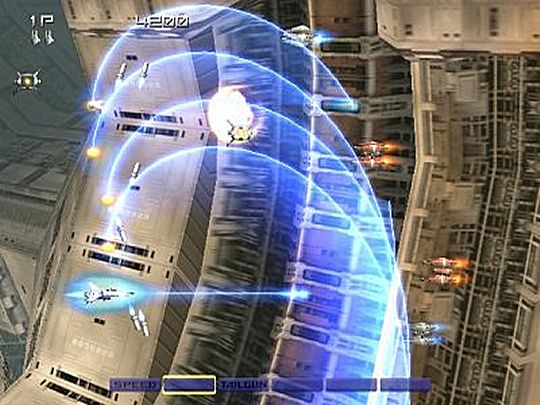
"Set the lasers to maximum bend!" Contrary to most people's expectations (including this writer's), 2004 has been a great year for old-fashioned arcade games. From R-Type Final (to which Gradius V is an excellent companion, with as many similarities as differences) to the aforementioned OutRun 2, to Virtua Racing: Flat Out, to a string of surprisingly fun PC games like Hamsterball, Deadeye, Superstar Chefs and Lightning Break Snooker, to the flawed-but-fab Burnout 3, and now to this, it's been years since there was so much quality out there for those of us who yearn for games you don't need 46 controls and three days of reading the manual and trekking through the sodding tutorial to enjoy. Heaven knows, viewers, real life has more than enough gruelling work and tedium in it as it is without looking for more of it from our videogames.
And once again, the best games are nearly all the cheapest ones. You won't find much in this world for under 18 quid that'll put as big a smile on your face as Gradius V. Go get it.
|

